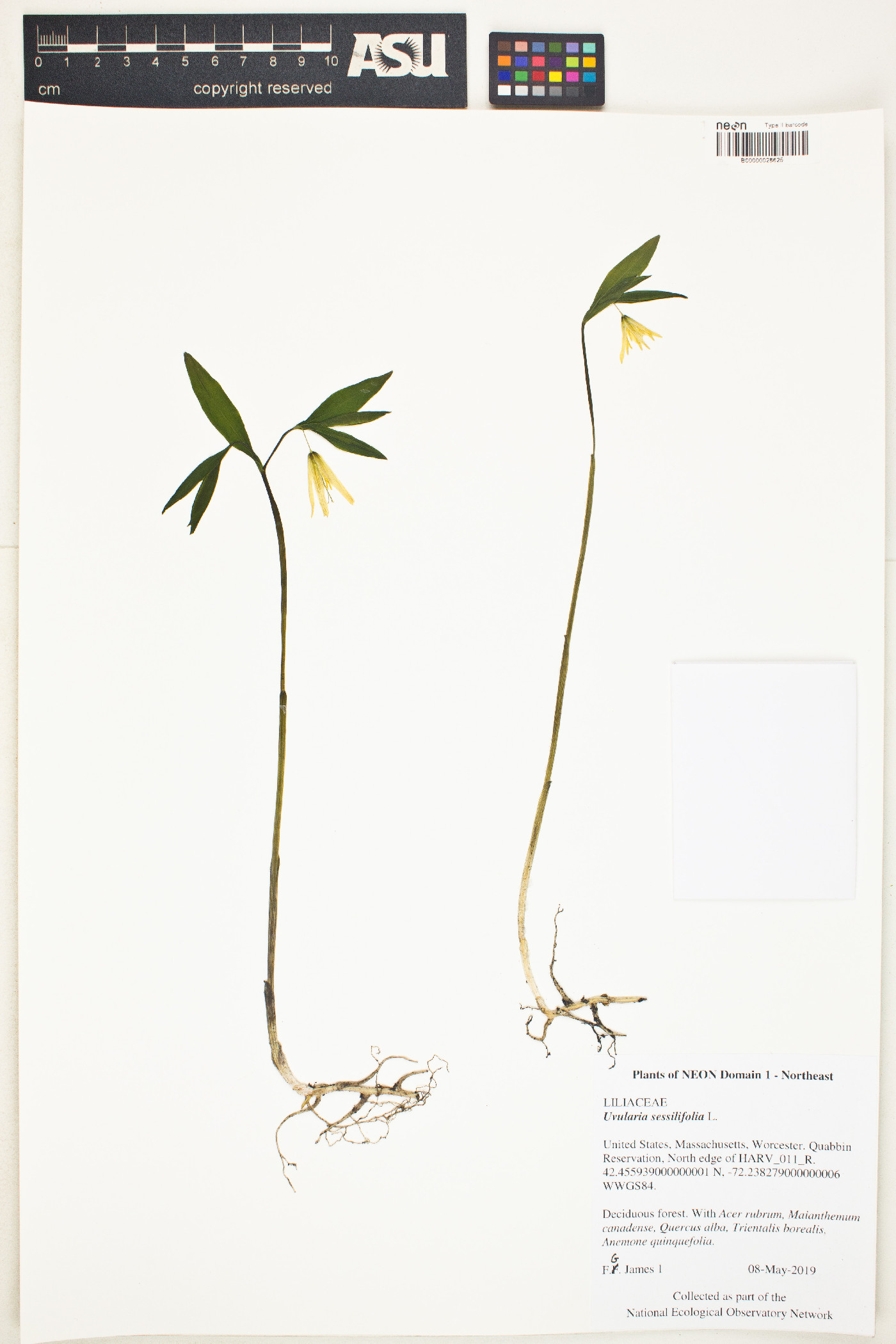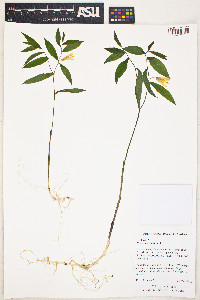|
Family: Colchicaceae
sessileleaf bellwort
[Oakesiella sessilifolia (L.) Small] |
Rhizomes elongate, slender, 10-15 cm, bearing scattered, fibrous roots; stolons present. Stem 1, 1-branched, angled distally, 1-4.5 dm, nodes glabrous, bearing 1-2 leaves below lowest branch. Leaf blades sessile, narrowly to broadly elliptic, 4-6.5(-8) × (1.3-)1.6-2.8(-4) cm, glabrous abaxially, margins minutely denticulate, apex acute to acuminate. Flowers 1 per stem; peduncles 0.6-1.6 cm, ebracteate; tepals pale straw-yellow, 13-25 × 2-4.5 mm, smooth abaxially, apex rounded to acute; stamens 8-15 mm; anthers 5-12 mm; connectives 0.3-0.5 mm; ovary stipitate, sharply triangular, flowering stipe 0.8-1.2 mm; style 10-15 mm; stigma lobes 1-2 mm. Capsules sharply 3-winged, stipitate, ellipsoid, 2-3 × 1-1.6 cm, not beaked; fruiting stipe 2-5 mm. Seeds 3-5 mm; arils crested. 2n = 14. Flowering spring--early summer. Moist hardwood coves, alluvial bottomlands, thickets and xeric woods northwards; 0--1000 m; Man., N.B., N.S., Ont., Que.; Ala., Ark., Conn., Del., D.C., Fla., Ga., Ill., Ind., Iowa, Ky., La., Maine, Md., Mass., Mich., Minn., Miss., Mo., N.H., N.J., N.Y., N.C., N.Dak., Ohio, Okla., Pa., R.I., S.C., Tenn., Tex., Vt., Va., W.Va., Wis. Perennial herb with a elongate, slender rhizome stem 10 - 45 cm tall Stem: one, one-branched, upright, forked above the middle, with sheathing bracts at the base. Leaves: alternate, stalkless, 4 - 6.5 cm long, 1.5 - 3 cm wide, oblong lance-shaped to elliptic with a pointed tip, minutely toothed, with a waxy coating (glaucous) on the lower surface. One or two leaves grow beneath the fork of the stem. Flowers: one per stem, terminal (but appearing axillary), nodding, pale straw-yellow, narrowly bell-shaped, with six distinct tepals. Tepals over-lapping, 1.2 - 2.5 cm long, 2 - 4.5 mm wide, elongate, with a pointed tip. Flower stalk 0.6 - 1.6 cm long. Stamens six, 8 - 15 mm long. Fruit: a sharply three-winged capsule, distinctly stalked, greenish to yellowish brown, 1.5 - 3 cm long, 1 - 1.6 cm wide, ellipsoid. Seeds brownish red, nearly spherical. Similar species: The similar Uvularia grandiflora and U. perfoliata differ by having perfoliate leaves. Flowering: April to June Habitat and ecology: Rare in the Chicago Region. A substantial population was discovered in Porter County, Indiana growing in full sun between thickets in a cutover area. Typically found in rich woods. Occurence in the Chicago region: native Etymology: Uvularia comes from the word uvula (the soft lobe that dangles at the back of the throat) of which the drooping flowers resemble. Sessilifolia means stalkless. Author: The Morton Arboretum Stem 1-3 dm at anthesis, bearing 0-2 lvs below the fork and only 1 or 2 fls; lvs at anthesis lance-oblong, acute at both ends, glaucous beneath, at maturity elliptic, to 8 נ3 cm, obtuse or rounded at base, nearly smooth on the margins, tep pale stramineous, 12-25 mm; styles connate for three-fourths their length; about equaling the perianth, much exceeding the anthers; fr 3-angled, distinctly stipitate, 15-20 mm; 2n=14. Woods; N.S. and N.B. to Minn. and S.D., s. especially in the mts., to S.C., w. Fla. and La. Apr., May. (Oakesia s.; Oakesiella s.)
Gleason, Henry A. & Cronquist, Arthur J. 1991. Manual of vascular plants of northeastern United States and adjacent Canada. lxxv + 910 pp.
©The New York Botanical Garden. All rights reserved. Used by permission. |


